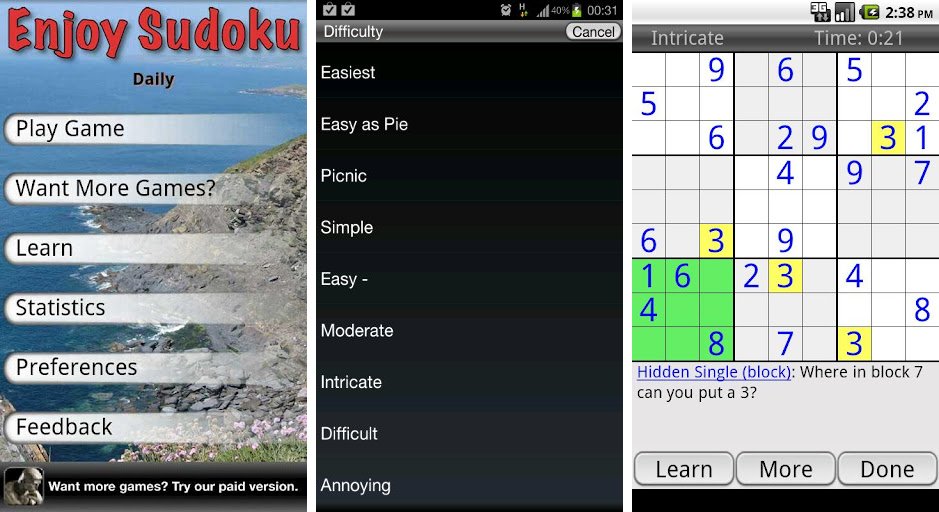


court accusing them of conspiring to artificially inflate the price of iPhones and iPads sold on Amazon's platform, a federal judge in Seattle ruled on Thursday.
#BEST SUDOKU APP 2018 DOWNLOAD#
I used a combination of some heuristics and FeaturePoint detection to place puzzles on non-horizontal planes.” – Brad Dwyer, Founder at Hatchlingsīrad and his colleagues at Hatchlings still need to work out the business model behind the ARKit Magic Sudoku app, but that’s in the meantime, download the app and let me and them know what you think: subscribe to his medium blog or follow Brad on twitter.Apple and must face a consumer antitrust lawsuit in U.S. Solving this was a trickier problem but I did come up with a hacky workaround. Problem number two was that ARKit only supports horizontal planes like tables and floors (not vertical planes like computer monitors). I pulled an all nighter that first week and re-trained our model with puzzles on computer screens. “Problem number one was that our machine learning model was only trained on paper puzzles it didn’t know what to think about pixels on a screen. However, when it aired, many users wanted to quickly test it and searched for Sudoku images on Google, which the app wouldn’t process that well. One minor deficit was that the app was trained on paper Sudoku’s. The results were amazing as the application had a 98.6% accuracy on launch (currently above 99% accuracy). This whole process reminds me on a blog I wrote recently, regarding human-computer interactions in reinforcement learning.įor several more weeks, users classified more scanned data so that, by the time the app was launched, it had been trained on over a million images of Sudoku squares. Funnily enough, they programmed it in such a way that users were periodically shown already known/classified images in order to check the validity of their inputs and determine how much to trust their answers going forward. Quickly, the developers had enough verified data to add an automatic accuracy checker into both tools for future data runs. These were subsequently thrown back into the first tool to be reclassified. So Brad created a second tool that displayed 100 images of a single class to users, who where consequently asked to click the ones that didn’t match. Nevertheless, some users had misunderstood the task (or just plainly ignored it) and as a consequence there were still a significant number of misidentified images. Within 24 hours, all 600,000 images were classified! Via a simple game, they asked Hatchlings users to classify these images by pressing the number keys on their keyboard. In the end, this server contained about 600,000 images, but all were completely unlabeled. Particularly the training process of the app interested me. In his blog, Brad explains how they bought out the entire stock of Sudoku books of a specific bookstore and, with the help of his team, ripped each book apart to scan each small square with a number and upload in to a server. This seemed like a realistic app to tackle.” – Brad Dwyer, Founder at Hatchlings I wanted to dip my toe in the water of Machine Learning while working on a real-world problem. “ One of the original reasons I chose a Sudoku solver as our first AR app was that I knew classifying digits is basically the “hello world” of Machine Learning. What happens in the ARKit app behind the scenes. Finally, a 3D-model of the solved puzzle is fed back to ARKit and displayed on top of the original image from the camera.Once enough numbers are gathered, a traditional recursive algorithm solves the puzzle.Each square is run through a neural network to determine what number (if any) it represents.If a puzzle is found, it is split into 81 square images.If rectangles are found, it is determined whether they are a Sudoku.iOS11’s Vision Library detects the rectangles in the image.ARKit gets a new frame from the camera.In several seconds, the following occurs behind the scenes: Magic Sudoku gives a magical experience when users point their phone at a Sudoku puzzle: the puzzle is instantaneously solved and displayed on their screen. The app works on iPad Pro’s and iPhone 6s or above and can be downloaded from the App Store. This app by a company named Hatchlings automatically solves sudoku puzzles using a combination of Computer Vision, Machine Learning, and Augmented Reality. A few weeks ago, Magic Sudoku was released for iOS11.


 0 kommentar(er)
0 kommentar(er)
